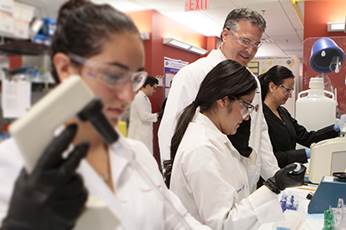Basic Project
Identification of novel molecular targets for early detection, treatment, and monitoring of leukemia and lymphoma within the Hispanic population
Leukemia. In the United States, nearly 146,250 new cases of blood cancers are expected to be diagnosed in 2020 [1]. Leukemia, a form of cancer that affects white blood cells found in the bone marrow and blood, will account for approximately 60,530 of these cases and will be responsible for 23,100 deaths. Of these new diagnoses, 21,040 will be classified as chronic lymphocytic leukemia (CLL), 8,450 chronic myelogenous leukemia (CML), 19,940 will be acute myelogenous leukemia (A.M.L.), and 6,150 will be acute lymphocytic leukemia (ALL) [2]. Despite an approximate 85% cure rate, ALL remains the second most common cause of cancer-related mortality in children in the U.S. [3].

The Paso del Norte Region. The El Paso-Juarez Borderplex has a population of approximately 2.5 million residents, with 840,758 residents located on the U.S. side of the border [11]. More than 82% of El Paso County, TX residents are Hispanic [11], 96% of Mexican origin [12-14]. Not surprisingly, age-adjusted ALL incidence rates for El Paso county were higher compared to regions of Texas [15]. Current therapeutic strategies lead to a refractory or relapse response in certain populations. Alarmingly, less than 2% of genome-wide studies are from Hispanic samples. Therefore, there is a pressing need to study oncogenic drivers within this population.
Cancer is the second leading cause of death in the United States and the primary cause of death for Hispanic Americans as first reported in 2012 [1, 18]. “Health disparities” contribute to cancer initiation, development, incidence, prevalence, and severity. The National Cancer Institute (NCI) defines cancer health disparities as “adverse differences in cancer incidence, prevalence, death, survivorship, and burden of cancer or related health conditions that exist among specific population groups in the United States [19].” A key population characteristic is defined by race and ethnicity, and cancer exerts a marked detrimental effect on the Hispanic demographic. While socioeconomic status (income, education, access to health care), geographic location, culture, sex, early detection, and treatment services are important cancer risk factors, genetic drivers associated with race and ethnicity play an equally influential role in cancer health disparities such as leukemia. Importantly, advances in targeted therapies now allow physicians to personalize treatment strategies based on an individual’s genetic content.
|
Investigative Team Dr. Robert A. Kirken (Principal Investigator), is the Dean of the College of Science at the University of Texas at El Paso (UTEP) and has served as the Program Director of the NIH-NCRR-RCMI Sponsored Border Biomedical Research Center (BBRC) for 10 years. Dr. Georgialina Rodriguez (Co-Investigator), is an Associate Professor of Research within the Department of Biological Sciences at UTEP and is a faculty member of the BBRC. Dr. Rodriguez is a cancer biologist and immunologist with experience investigating the molecular mechanisms that drive kinase-mediated diseases such as leukemia. Her work focuses on better understanding phospho-regulation of Jak proteins in order to generate small molecule inhibitors which more selectively target oncogenic kinases, like Jak3, in contrast to the current pan-kinase inhibitors available. Dr. Chuan Xiao (Co-Investigator), is an Associate Professor of the Department of Chemistry at UTEP. Dr. Xiao is a structural biochemist, with interests in virology, chronobiology, cancer, and plants. He combines X-ray crystallography, cryogenic electron microscopy, and other bioinformatics, biophysical, and biochemical tools to study the structures of biological complexes and analyze their functions. Dr. Lin Li (Co-Investigator), is an Assistant Professor of the Department of Physics at UTEP. Dr. Li's research interests focus on Computational Biophysics, and his main research goals are to: 1) develop state-of-the-art software packages for modeling and simulation of disease-related biological systems 2) use computational approaches to study disease-related biological systems. He has additional interests in bioinformatics, protein interactions, viral capsid assembly, and molecular motors. |
| Publications |
Symposium Abstract Presentations by undergraduate students related to the project’s research: |
| Abstracts |
|
| References |
|




